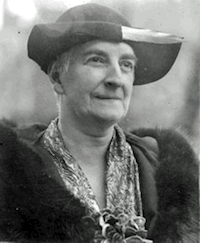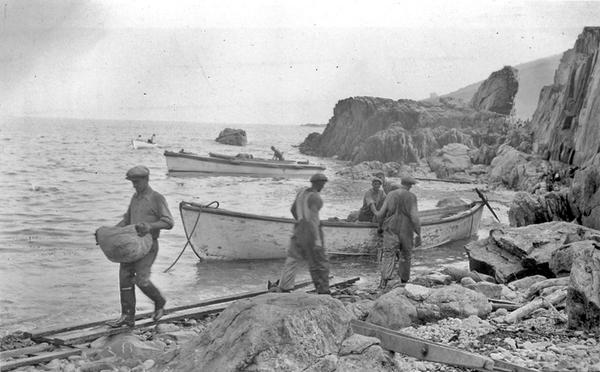30 Sep An early photo of Ciboux Island, and the remarkable woman who took it.
The Twitter feed of the Nova Scotia Archives posted this photo today, with the caption, “Loading supplies at Ciboux Island, ca. 1937.” The supplies, one presumes, were bound for the manned lighthouse that once operated there, a facility long since replaced by an automated light tower.
Ciboux is the more northerly of the two Bird Islands: long, narrow outcroppings described by steep cliffs, and lying in a straight line off Cape Dauphin in Victoria County. They comprise one of the most important seabird sites in Nova Scotia, and are home to the largest colony of Great Cormorants in North America. Numerous other seabirds breed there, including the more common Double-crested Cormorants, Atlantic Puffins, Razorbills, Guillemots, and Kittiwakes. The province designated the islands as a protected wildlife area in 2009, and severely restricts access.
 Nearly as interesting as the islands is the photographer, Clarissa Archibald “Clara” Dennis (1881-1958), pictured at left, a remarkable Nova Scotia woman who was, as Lauren Oostveen notes, “one of the province´s first travel writers, and the first woman to write extensively about Nova Scotia from a personal perspective.”
Nearly as interesting as the islands is the photographer, Clarissa Archibald “Clara” Dennis (1881-1958), pictured at left, a remarkable Nova Scotia woman who was, as Lauren Oostveen notes, “one of the province´s first travel writers, and the first woman to write extensively about Nova Scotia from a personal perspective.”
Dennis wrote two travelogues about Nova Scotia, Down in Nova Scotia (1934) and More about Nova Scotia (1937); and one about Cape Breton, Cape Breton Over (1942). She was the daughter of Independent-Conservative Sen. William Dennis, editor-in-chief and president of the Halifax Herald from 1890 until his death in 1920; and of Agnes (Miller) Dennis, a community leader active in progressive women’s circles, and keen on improving conditions for disadvantaged women and children. (The current Chronicle Herald publisher, Sarah Dennis, is, if my calculations are correct, Clara’s first cousin twice removed.)
A biographical sketch in the Nova Scotia Archives describes Dennis’s writing as, “very much a product of its time and place.”
[S]he had an observant eye, a keen sense of popular history, and a conversational writing style with a cadence and charm all its own. Hardly significant today, her books nevertheless captured a Nova Scotia that exists no more. Working in the inter-war years and travelling the province at the time of the Great Depression, Clara met many people, saw many things, and was relentlessly optimistic in her observations. Critical analysis was not part of her agenda.
Dennis had a particular interest in the province’s Mi’kmaq. From a series of interviews in the 1920s, she transcribed the life story of Jerry Lonecloud, a Mi’kmaq guide, lumberer, showman, and herbalist who is sometimes described as the first Mi’kmaq ethnographer (based on Dennis’s interviews).
Upon Dennis’s death in 1958, the historical importance of her papers went unrecognized, and many were lost. Her photographs, however, did survive. The Nova Scotia Archives maintains a searchable online trove of more than 2500 images, including the one of Ciboux Island, above. Most were taken between 1930 and 1940. Anyone interested in Nova Scotia history and culture will find the collection irresistible.

